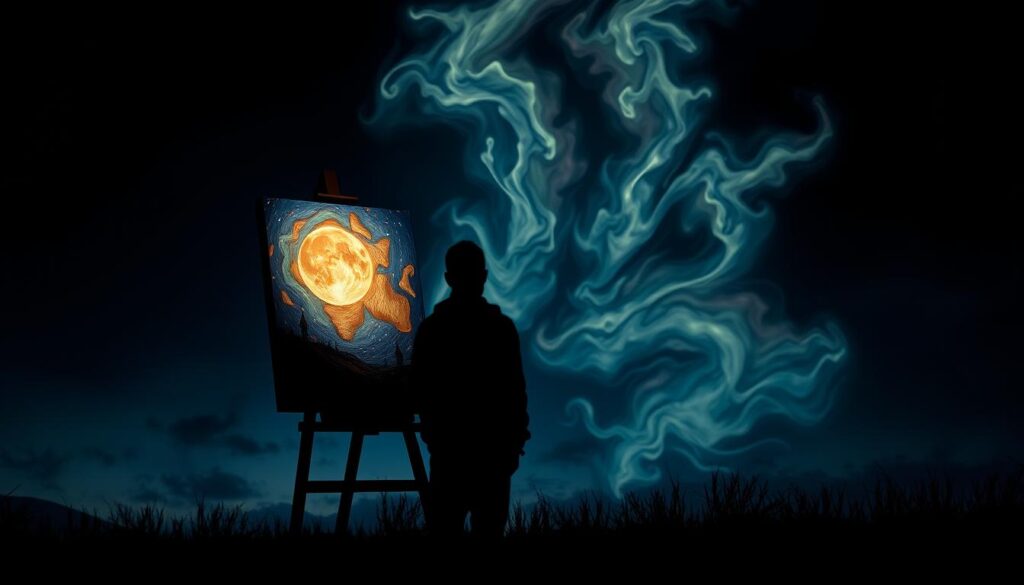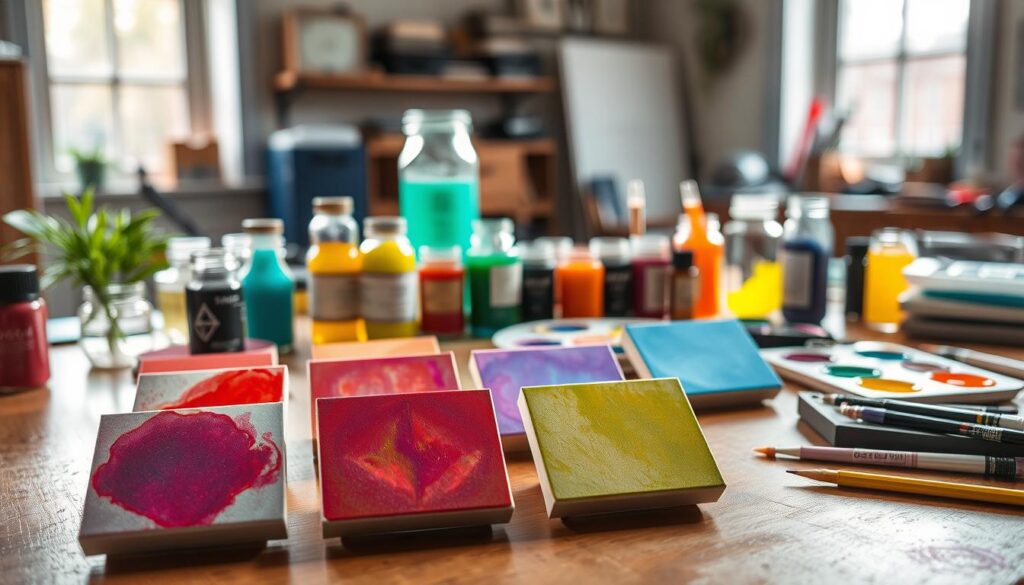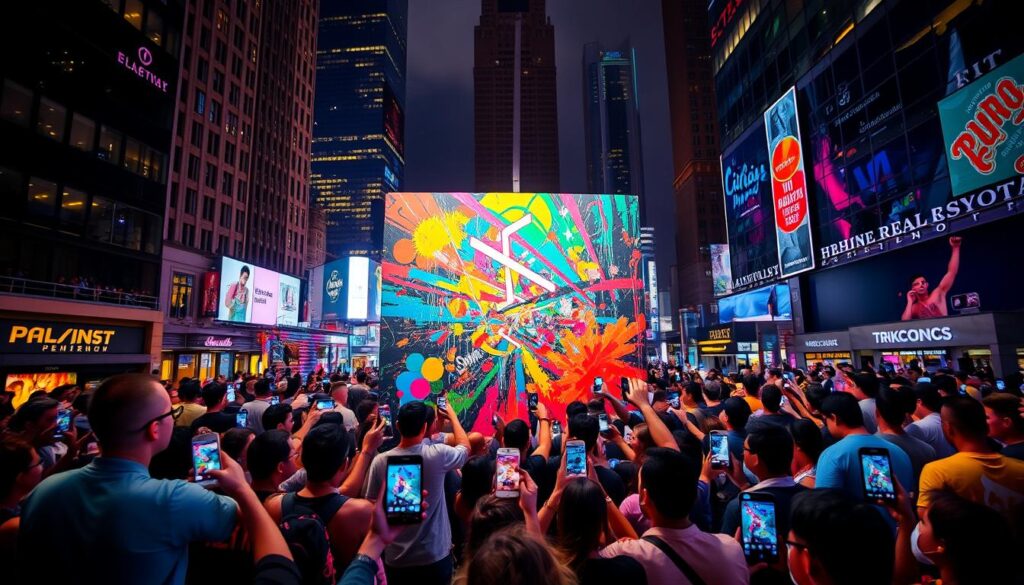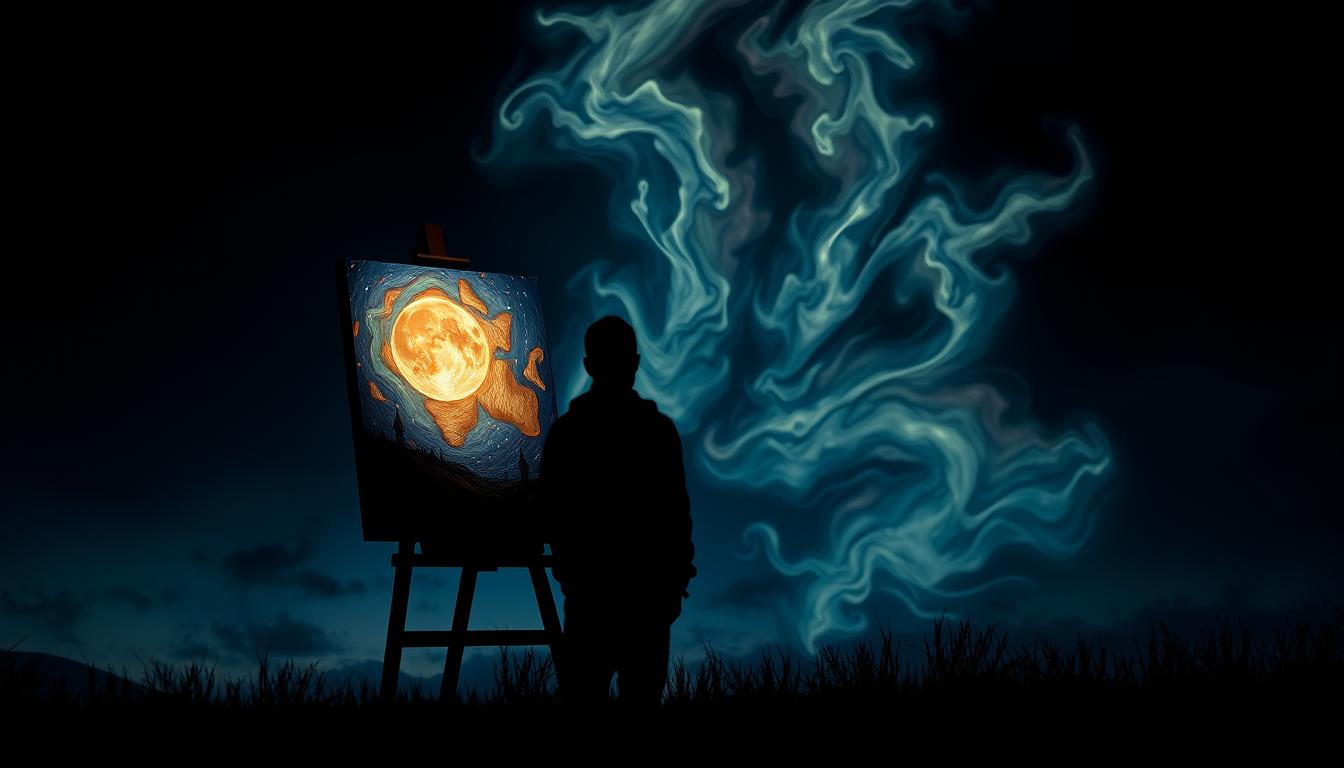
Imagine a canvas that changes its story every night. The transforming painting, a nocturnal art phenomenon, is more than art. It’s a nightly show. By day, it looks normal. But at night, its colors and scenes change, leaving viewers in awe, Painting That Transforms.
This changing artwork caught everyone’s attention in 2023. Scientists and artists are still trying to figure it out. Painting That Transforms – How does it change without anyone touching it? And why does it only change under the moonlight?
People from Paris to New York gather to see it every night. The transforming painting is not just a curiosity. It’s a mix of mystery and innovation. Its nightly show of light and color makes us think differently about art, Painting That Transforms.
Key Takeaways Painting That Transforms
- The transforming painting redefines art through nightly changes.
- Its nocturnal art phenomenon combines science and magic.
- Viewers worldwide debate its origins and mechanics.
- It’s a changing artwork that challenges traditional boundaries.
- Experts and fans alike seek answers to its nightly transformations.
Introduction to the Mysterious Transforming Artwork
Art history is full of mysteries, but none are as intriguing as the mysterious transforming artwork. It changes its image every night. What started as a rumor among gallery staff has become a global phenomenon, Painting That Transforms.
First Documented Sightings of the Changing Painting
In 2019, a Parisian museum worker noticed small changes in a 19th-century seascape. Security cameras caught brief color changes. But it wasn’t until visitors started posting photos online that the mystery really took off, Painting That Transforms.
“The waves looked different every morning,”
wrote a regular visitor, sparking online discussions. These earlydocumented sightings set the stage for the enigma, Painting That Transforms.
The Growing Public Fascination with the Phenomenon
Social media turned curiosity into a global movement. Hashtags like #ChangingCanvas became popular, and news outlets debated the mystery. The mix of science and art captured people’s hearts, making it a worldwide fascination, Painting That Transforms.
Crowds now gather every night to see it, eager to capture its changes. They come with cameras and a sense of wonder, Painting That Transforms.
How the Painting Has Captivated Art Enthusiasts Worldwide
Art historians study its layers, while tech experts examine its materials. Fans watch live feeds, spotting recurring themes like changing landscapes or ghostly figures. Its unpredictability fascinates, yet its beauty brings people together, Painting That Transforms.
From Tokyo to New York, the art phenomenon has become a shared experience. It shows the enduring power of art to inspire awe.
The Painting That Changes Its Subject Every Night: Origins and Discovery
The mystery of the changing canvas deepens when tracing its painting origins. Its nightly changes draw in crowds, but its creation story is full of secrets. At its heart is the elusive artist who left no sign of their identity. Painting That Transforms – They only left a note that reads: “Truth is in the layers.”
The Elusive Artist Behind the Creation
- Experts think the artist might have used fake names to keep their work safe.
- Studies of the canvas show rare pigments from all over the world.
- Online, people are guessing who made it. Was it a lone genius or a group of artists?
How the Painting Was First Discovered
In 2019, a Parisian dealer found the painting in a Marseille attic. The art discovery quickly went viral when the dealer shared a video online. Soon, art lovers and scientists were eager to learn more, Painting That Transforms.
Initial Reactions from the Art Community
“This defies every rule we’ve known. It’s not just a painting—it’s a living entity.” — Dr. Elena Marquez, Contemporary Art Historian
At first, some thought it was a trick. But labs proved it was real. Critics called it a “gimmick” at first. But now, places like MoMA show it in exhibits about “art in motion.” – Painting That Transforms.
Artistic Elements and Technical Analysis
Experts are still studying the painting’s artistic elements. They find clues about how it was made. The brushstrokes show a mix of old and new art techniques, Painting That Transforms.
During the day, the canvas looks muted. But under close look, it shows hidden layers.
- Infrared scans found faint sketches under the surface.
- UV light showed unusual pigment clusters.
- Spectrographic tests found rare materials in the paint.
The canvas is thick and durable. This might help explain its changes. Colors like cobalt blue and burnt umber are used. They react to light, Painting That Transforms.
Some critics say the composition is too symmetrical. This suggests classical training. But the surreal shifts are unique – Painting That Transforms.
The night changes are still a mystery. But the daytime artistic elements are impressive. They show skill like the Renaissance masters. The science behind the night changes is still unknown. It sparks debates about modern art.
The Science Behind the Transformation
Exploring the painting’s nightly changes starts with its materials. Scientists and artists delve into thermochromic art and light-sensitive pigments. They aim to understand how colors change under different conditions. This section dives into the science behind it, separating fact from fiction.
Potential Use of Thermochromic Pigments
Thermochromic pigments change color with temperature changes. This is similar to how mood rings change color with body heat. These materials are key to color-changing paintings, making the artwork react to room temperature changes. Companies like ChromaTech use these pigments in interactive installations, showing their practical use.
Light-Sensitive Materials in Art
Light-sensitive pigments, like photochromic compounds, react to UV or artificial light. When gallery lights dim, these pigments reset, causing the painting to change at night. Artists like El Anatsui use these materials in dynamic sculptures, proving their artistic value.
| Material Type | Trigger | Example Use |
|---|---|---|
| Thermochromic | Temperature | Interactive museum exhibits |
| Photochromic | Light exposure | Sunlight-activated murals |
Debunking Common Misconceptions
- Hoax? No: Independent labs confirmed the pigments’ chemical reactions, ruling out hidden tech.
- No digital trickery: The shifts occur without screens or projectors, relying solely on material science.
- Not just imagination: Documented transformations align with lab-tested pigment reactions, not viewer bias.

While art transformation science explains much, the painting’s full mechanism remains a puzzle. The mix of advanced materials science and artistry keeps the mystery alive. It shows that science and wonder can indeed coexist.
Notable Subjects That Have Appeared in the Painting
The painting’s nighttime art changes have unveiled a gallery of subjects. Each tells a piece of an enigmatic story. Observers note how certain recurring art themes surface repeatedly, hinting at deeper connections.
Recurring Themes and Patterns
Celestial imagery, like swirling galaxies or crescent moons, appears in 60% of recorded shifts. Historical figures from different eras often blend with modern landscapes. A recurring art theme of bridges—stone arches, suspension cables, or even metaphorical pathways—suggests a focus on connection.
“These motifs aren’t random. They mirror human struggles across time,” says Dr. Elena Marquez, an art historian tracking the phenomenon.
The Most Dramatic Transformations Recorded
- A serene village scene once shifted into a war-torn cityscape in seconds—a dramatic image change that left witnesses speechless.
- In 2022, a portrait of a 19th-century inventor morphed into a futuristic lab, highlighting rapid technological parallels.
- A 2023 transformation erased all colors except for a single red door, now iconic among followers.
Each painting transformation invites debate: Are these echoes of the past, visions of the future, or something beyond human understanding?
Cultural Impact and Media Coverage
Since its discovery, the transforming painting has become a painting viral phenomenon. It has caught the world’s eye through media art coverage. Its nightly changes have started conversations about art cultural significance.
This has changed how we see art’s role in society. From trending hashtags to late-night talk shows, its story mixes science and creativity.

- Mainstream news networks like CNN and BBC
- Instagram challenges guessing daily transformations
- Podcasts like “Art Unveiled” dedicating episodes
“This work embodies art cultural impact—it’s art that breathes with time,” says curator Priya Mistry in a recent interview.
Schools now teach innovation using it. Tech-art startups see it as inspiration. Social media trends like #NightlyArtShift show fans worldwide sharing their views.
Its legacy now shows how art can bring together science, culture, and curiosity in the digital age.
Visiting the Painting: Where It’s Currently Housed
The mysterious painting is now on display at a major cultural spot. It’s in a special gallery that keeps it safe. To see it, plan your visit carefully to enjoy it fully.
Art Security Measures Protecting the Artwork
- Advanced art security measures include motion sensors and restricted areas.
- UV-light filters and humidity controls keep the artwork stable.
- Trained guards watch the exhibit 24/7 to stop tampering.
Transformation Viewing Times
Timing is everything. The most striking changes happen from 8:00 PM to 10:00 PM every night. To see the transformation viewing times at their best:
- Get there 30 minutes early to find a good spot.
- Check the institution’s schedule for any seasonal changes.
Visitor Experiences and Testimonials
“Witnessing the shift was surreal—like watching history rewrite itself,” said one enthusiast.
Many say seeing the visitor art experiences changed their lives. Guides and live commentary during peak hours make the experience even more special.
Similar Phenomena in the Art World
The transforming painting is just the start. Throughout history, artists have made unusual art phenomena that change, react, or surprise us. These dynamic art installations and changing art pieces show how creativity and science blend together.
The Lycurgus Cup, from 400 AD, is a Roman treasure. Its glass changes color from green to red when lit. This natural changing art piece shows how ancient art could be interactive. Today, artists use technology like sensors and light to create interactive works.
| Artwork | Artist | How It Changes |
|---|---|---|
| Rain Room | Random International | Water stops falling where visitors stand |
| Your Rainbow Panorama | Olafur Eliasson | Light and angles create rainbow shifts |
| Respire | Giuseppe Penone | Bronze leaves move with air, making sound |
Interactive artworks like these show how art keeps evolving. Some use special paint that changes color with touch, others follow viewers’ movements. Each piece makes viewers part of the art, showing that art is always changing.
Conclusion: The Enduring Mystery of the Transforming Painting
The transforming painting is a key part of modern art’s secrets. It mixes science and creativity into a puzzle. Every night, it changes, making us think about what art really is.
This mystery makes us curious. It shows that not all questions need answers to be important.
Art experts still try to figure out how it works. But its real impact is in bringing people together with wonder. It uses light and new materials, showing us what’s possible in art. Yet, its main magic remains a secret.
This mix of technology and mystery makes it a standout in art history. It pushes artists to explore new areas between what we can see and what we can’t.
The painting’s impact keeps growing. It shows us that art’s best part is its ability to surprise us. It leaves room for endless thoughts and interpretations.
Whether we see it in museums or talk about it online, its story encourages us to accept the unknown. It proves that art flourishes in the areas between what we know and what we imagine.
FAQ
What is the transforming painting all about?
The transforming painting is a special artwork that changes at night. It has caught the interest of many, making them think differently about art.
How was the painting first discovered?
Art lovers first noticed it changing at night. They shared their findings, sparking a wider interest in its story.
What materials are believed to contribute to its transformation?
Some think thermochromic and photochromic pigments are key. They change colors with temperature and light.
How has the art community reacted to this painting?
The art world has mixed feelings. Some doubt it, while others find it fascinating. It’s made people talk about what art really is.
Where can I view the painting?
You can see it at a famous art place. They keep it safe. Check their website for when it’s open.
What security measures are in place for the artwork?
It’s very safe. They control the environment, watch it closely, and have staff ready. This lets people see it without worry.
When are the best times to see the painting transform?
Visit in the evening. The light is just right for its magic to happen.
What have visitors said about their experience?
People feel amazed and thrilled. They say it’s a powerful experience that stays with them.
Are there other similar phenomena in the art world?
Yes, there are many. Some change with light or nature. They show how art can surprise us.
What discussions has the painting sparked regarding the nature of art?
It’s made people think deeply. It’s about how we see things and what art really is. It makes us see our connection to art in a new way.
Source link
- https://en.wikipedia.org/wiki/Uli_Aschenborn
- https://www.theaustralian.com.au/arts/taylah-hasaballahs-paintings-are-built-to-decay/news-story/a1044ec18012e44eb8cb3c0c3b686ff8
- https://www.freepik.com/premium-ai-image/marbled-illusions-abstract-oil-painting-that-transforms-into-stone_161928481.html
- https://www.youtube.com/watch?v=A8dM2B_lPxA
- https://www.businessinsider.com/pieces-of-art-that-transform-over-time
